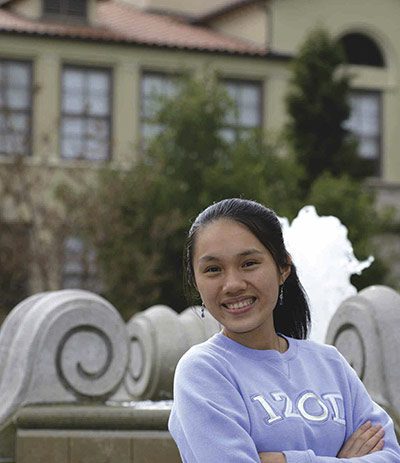 Hong Deng Gao ’15
Hong Deng Gao ’15
MAJOR: History
SUPPORTED BY: Financial Aid, Draper Center for Community Partnerships, Summer Undergraduate Research Program, The Annual Fund
A native of China, Hong and her mother moved to Brooklyn in 2005. When her mother developed life-threatening liver disease, Hong helped her navigate the often confusing public hospital system. Determined to improve access to health care for other low-income immigrants, Hong developed a proposal through the Draper Center to train college volunteers as health navigators for patients with limited English proficiency and literacy. Hong devotes much of her free time to the Draper Center, working as a coordinator for programs such as Alternabreak, a community engagement spring break program.
History as explanation
“Because of my immigrant background, I like to trace things back to their origins, whether it’s the earliest pilgrims, or Chinese immigrants who came in the 1800s, or recent refugee groups. It can really help explain some of what we see now. Why do Chinatowns exist in the U.S. today? What were the Chinese discriminatory laws that were passed back then and how do they still impact people today?”
In the library and on the ground
“I’ve been working with Professor (Samuel) Yamashita on the impact Chinese restaurants have had on Chinese-American communities. In the summer after my sophomore year, I went to New York, where I interviewed and observed children who help out in their parents’ Chinese takeout restaurants and Korean grocery stores. I went back to New York this summer, and to Honolulu and San Francisco, where I conducted archival research in local libraries and museums on high-end Chinese restaurants. I wanted to know what these upscale restaurants mean in the context of Chinese immigration and race relations, and the history of restaurants in the three cities. So, in a sense, my research has been both sociological and historical.”
A mother’s struggle, a daughter’s inspiration
“My mom was the inspiration for my social entrepreneurship project with the Draper Center. She had liver disease, and from the time I was about 15 years old, I helped her deal with the public hospital system, because it was hard for her to do it on her own. She didn’t really speak any English and couldn’t read the signs or the documents or bills. When I got to Pomona, I started thinking more about this issue and how I could help other non-English speaking immigrants.”
Building a bridge to better health care
“The idea I came up with is Health Bridges, where bilingual college volunteers work with local hospitals to give parents like my mom the emotional support they need and help them understand and navigate the system.
The students are definitely going to be a lot more competent in understanding the hospital procedures than these immigrant patients who are already sick and tired and can’t really deal with the system anymore.” [Health Bridges is dedicated to Hong’s mother, Jian Li Lin, who died in 2011.]
Coaching from the Draper Center
“Emily Arnold-Hernandez ’99, who teaches a social entrepreneurship workshop at the Draper Center, helped us develop our visions, goals and budgets, and to understand every single detail of how nonprofit organizations work. Where do you get funding? What are all the questions that you need to think about and have prepared before you can pitch the proposal to a funder? It was really great. I’m planning to start a pilot project this semester and, if it works out, to take a gap year before grad school to fully develop the program in different hospitals and expand it to other college campuses.”
Academia and social change
“I’ve been thinking about the question of how to bridge academia with social justice and social change. Some people see them as very distinct fields, but I think as a scholar you can still make a huge impact in society. You can change the mindset of your audience. And if the audience is policy makers or other scholars or even college students, and if they go on and take this message with them, then that’s the impact that I’d like to have.”
Daring Minds
“When I think of Daring Minds, I think of three characteristics. One is to have a vision; second is to be willing to take the risk of implementing that vision; and third is accomplishing your goal by taking concrete steps, not being afraid of failure and persevering until the end.”
